宇多津には古くから寺社が立ち並び、今なお古き良き景観を残しています。
その数1社9か寺。
そのうちの一つである西光寺で開催された「うたづ寺子屋」にお邪魔しました。
夏休みに開催されるこのイベントでは、町内の小学生が地域の歴史について学ぶことができます。
Utazu is a town with a long history, where temples and shrines have stood for centuries. Even today, the townscape retains much of its traditional charm, with one shrine and nine temples still present.
This summer, we had the opportunity to visit “Utazu Terakoya,” an educational program at Saikō-ji Temple, where local elementary school students learn about the history of their town.
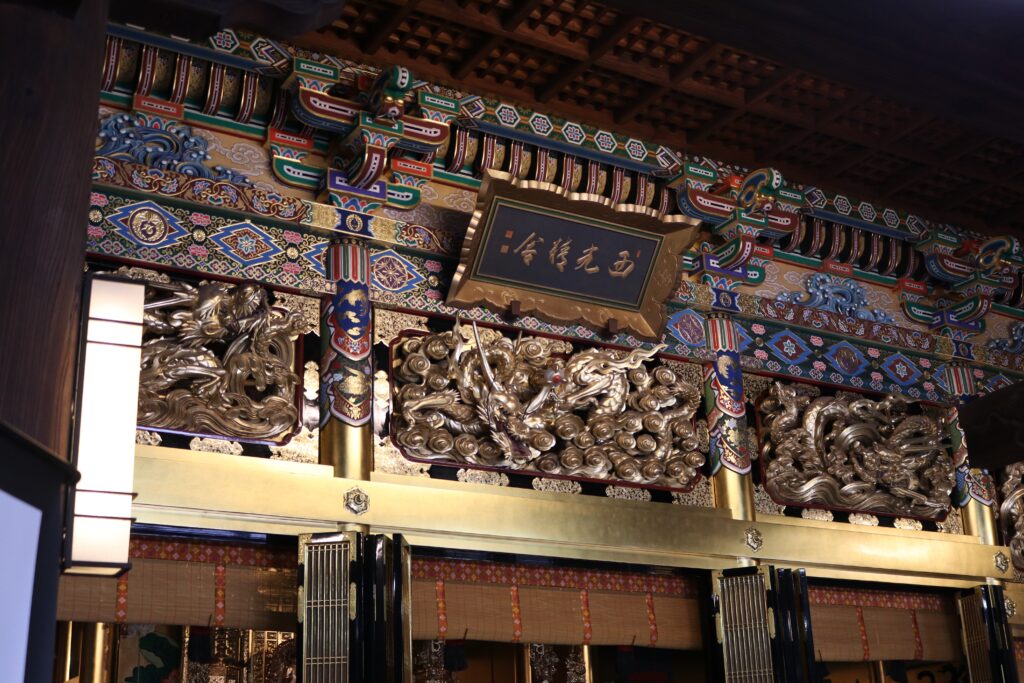
豪華絢爛な装飾が美しい西光寺 Saikō-ji Temple, adorned with magnificent and intricate decorations.
今回、宇多津の昔の様子について教えてくれたのは、
瀬戸内海歴史民俗資料館の館長、松岡明子さん。
江戸時代以前に描かれた絵画や絵馬から、当時の様子を読み解く方法を学びました。
A Lesson in History Through Art
This session was led by Akiko Matsuoka, director of the Seto Inland Sea History and Folklore Museum. She introduced us to historical paintings and ema (votive tablets) as tools for understanding what Utazu was like in the past.
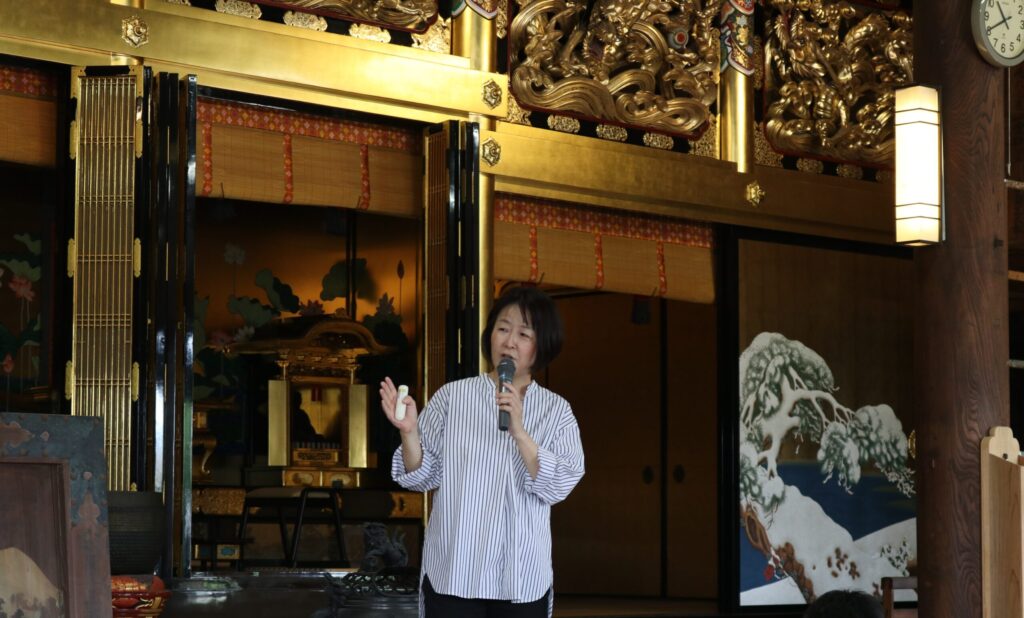
瀬戸内海歴史民俗資料館館長の松岡さん Ms. Matsuoka, Director of the Seto Inland Sea Museum of History and Folklore.
絵画はどう読み解く?
まず、高松城下と東かがわ市の水主神社、観音寺市街地を描いた3件の絵画をもとに、
古い時代の絵画を読み解くにはどのような見方をすれば良いかを教えてもらいました。
それぞれの絵を見てみると、人物やお城が大きく描かれていたり、あるはずのものが描かれてなかったり…。
実際に見る景色とは違う部分がいくつかありました。
A Lesson in History Through Art
This session was led by Akiko Matsuoka, director of the Seto Inland Sea History and Folklore Museum. She introduced us to historical paintings and ema (votive tablets) as tools for understanding what Utazu was like in the past.
How to “Read” Historical Paintings
To begin, we examined three paintings depicting:
- Takamatsu Castle Town
- Mizushi Shrine in Higashi-Kagawa City
- Kanonji City
We noticed that:
- People and buildings were drawn larger than life
- Some elements were missing or altered
For example, the painting of Mizushi Shrine exaggerated the size and number of sub-shrines to emphasize the shrine’s historical importance.
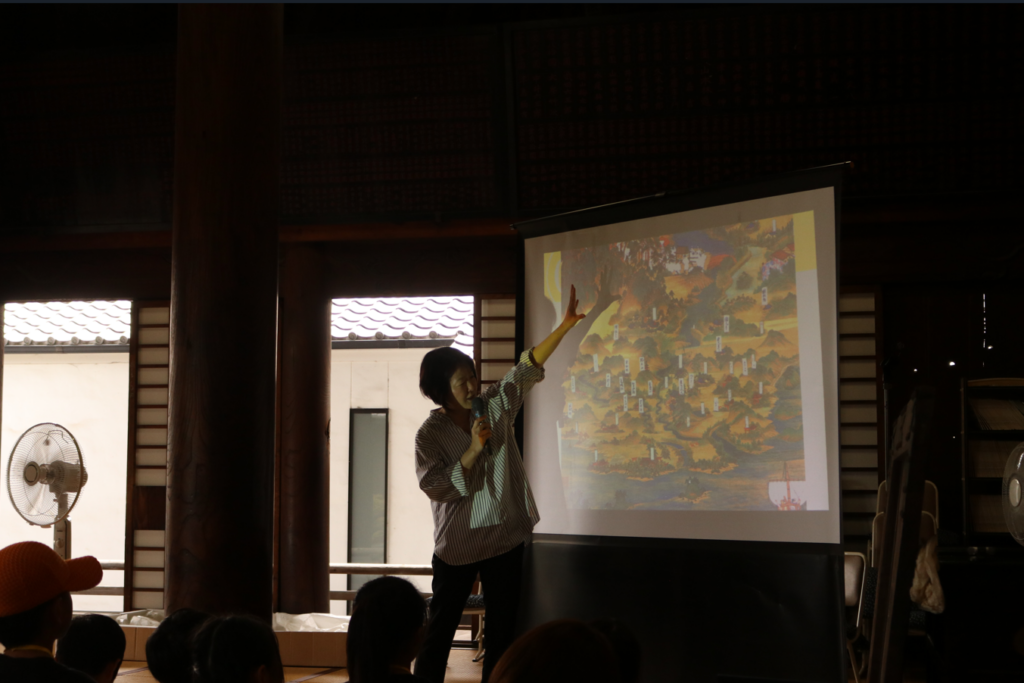
東かがわ市にある水主神社が描かれた絵画をもとに、絵画の見方をレクチャーする松岡さん。この絵は神社がメインで描かれており、縮尺が違っています。かつて、水主神社の付近にこれだけの末社があったということを表そうとしています。 ”Ms. Matsuoka giving a lecture on how to interpret a painting depicting Mizushi Shrine in Higashikagawa City. In this artwork, the shrine is the central focus, and the scale is intentionally altered. The painting aims to illustrate the number of subsidiary shrines that once existed around Mizushi Shrine.
この3件の絵画から学んだのは、描かれたもの=真実とは限らないということ。
また、いつ・どこで・誰が・どのように・なぜ描いたかについても考えることが、当時の様子を知ることに繋がるそう。
実際にあるべき姿とは違った「変」な部分に注目すると、より当時の事情や、絵師が絵画に込めた思惑が見えてきました。
Key Takeaways
- Paintings are not always accurate representations of reality.
- Understanding the context (who, when, where, why it was created) helps reveal its true meaning.
- Deliberate artistic choices—such as omissions or exaggerations—often reflect cultural or social messages.
松岡さん
「今は写真やテレビがあって、すぐスマホなどで調べることができますが、
この絵画が描かれた時代には、絵が情報を得るための重要な手段でした。
しかし、絵に描かれたものがそのまま正しいというわけではありません。
その時の伝えたい事によって、いろいろ工夫されたり、強調されたり、省略された部分があります。そのことを意識して見ることが大切です」
As Matsuoka explained:
“Today, we have photos, television, and smartphones to instantly look up information. But in the past, paintings were a crucial way to convey knowledge. However, what is depicted in the artwork is not always literal truth—artists altered details based on what they wanted to highlight or communicate.”
絵馬を見てみよう!
このように昔の絵画を見る時のポイントを学んだ後は、
宇多津の昔の様子が描かれた「網浦眺望青山真景図」を実際に見ながら、当時の様子を読み解きました。
Discovering Old Utazu Through an Ema Painting
After learning how to analyze historical paintings, we turned to an actual ema depicting Utazu in the Edo period:
“Aomiura Chōbō Seizan Shinkei-zu” (網浦眺望青山真景図)
Owned by Ubushina Shrine | Designated as a Utazu Town Cultural Property
This ema offers a glimpse into 19th-century Utazu, though some details have faded over time.
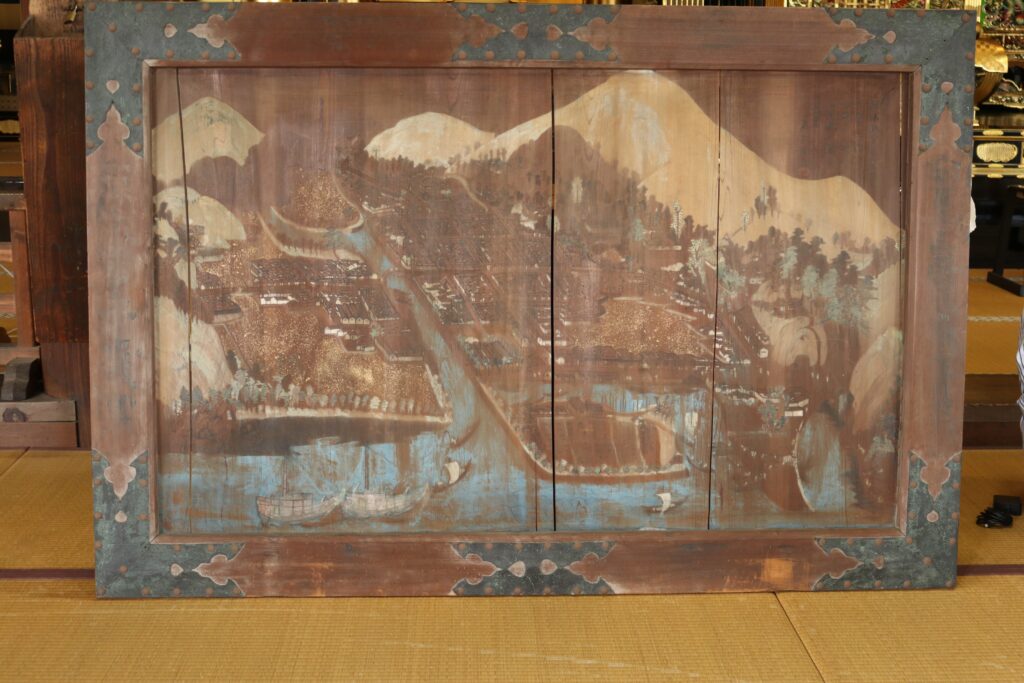
町指定有形文化財「網浦眺望青山真景図」(所蔵:宇夫階神社)表面 Utazu Town Designated Tangible Cultural Property Amiura Chōbō Seizan Shinkeizu (Owned by Ubuwaka Shrine), Front Side.
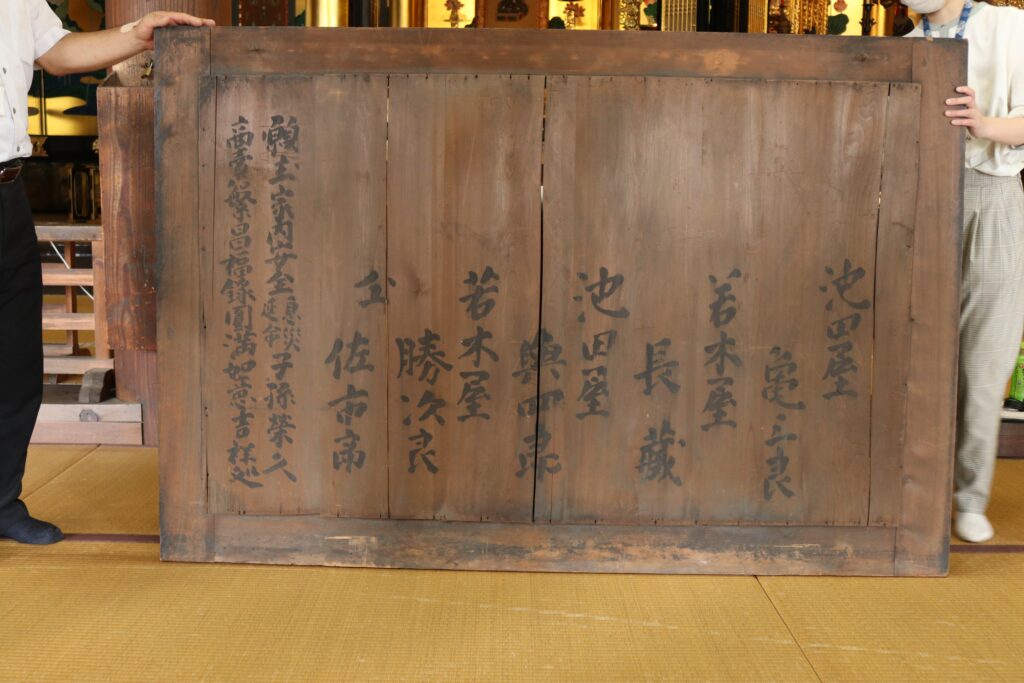
町指定有形文化財「網浦眺望青山真景図」(所蔵:宇夫階神社) 裏面 Utazu Town Designated Tangible Cultural Property Amiura Chōbō Seizan Shinkeizu (Owned by Ubuwaka Shrine), Back Side.
この絵馬の中には宇多津の寺社が描かれています。
消えて見えなくなっている部分もありますが、この絵馬の表裏に書かれた文字から、
安政2年(1855)に宇多津で池田屋、若木屋などが、絵師の萬年に宇多津の町(現在の古街あたり)を描かせたものだということが分かります。
さらに、裏面の墨書からは、それぞれの家に関わる人たちの安全や子孫繁栄、商売繁盛などの願いが書かれていることも読み取ることができます。
Key Observations from the Ema
Date & Origin:
The inscription on the backreveals that the painting was commissioned in 1855 (Ansei 2) by local merchants such as Ikedaya and Wakagiya.
The artist, Mannen, was hired to paint Utazu’s townscape, particularly the Co-machi (古街) district.
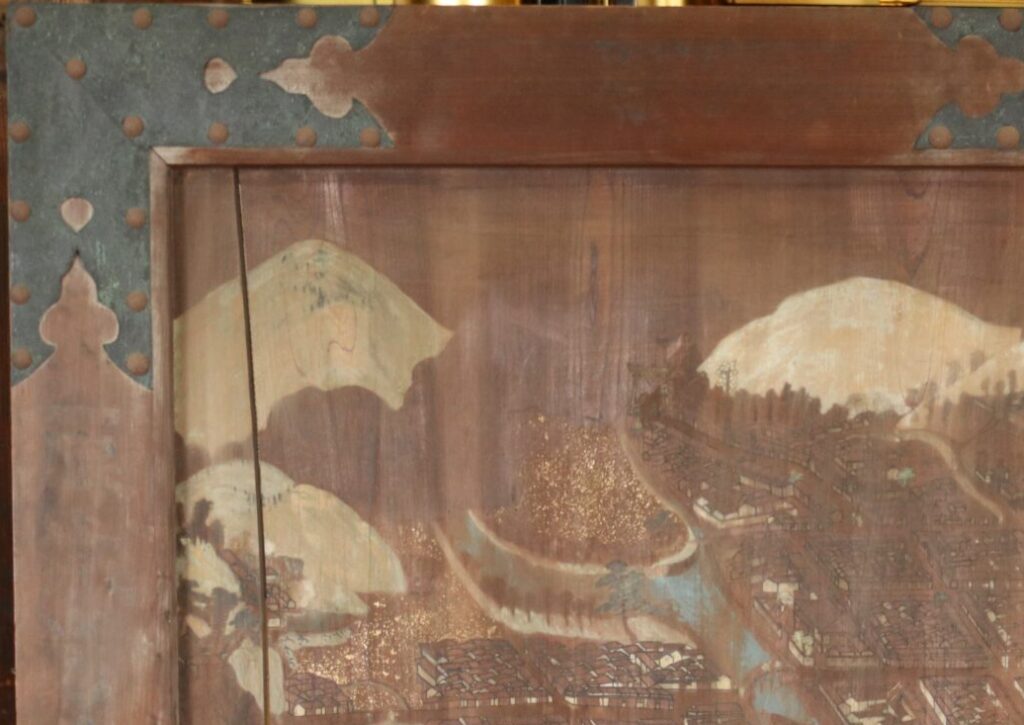
さらに詳しく見ると、絵馬の左上にある鳥居が他の物に比べて、大きく描かれています。
これは、こんぴらさんへの参詣道を示すもので、宇多津にこんぴら参りをする人が多く訪れたことを表しています。
Symbolism & Meaning:
The Torii gate in the upper leftis drawn larger than usual.
→ This highlights Utazu’s role as a gateway for pilgrims traveling to Kotohira Shrine (“Konpira-san”).
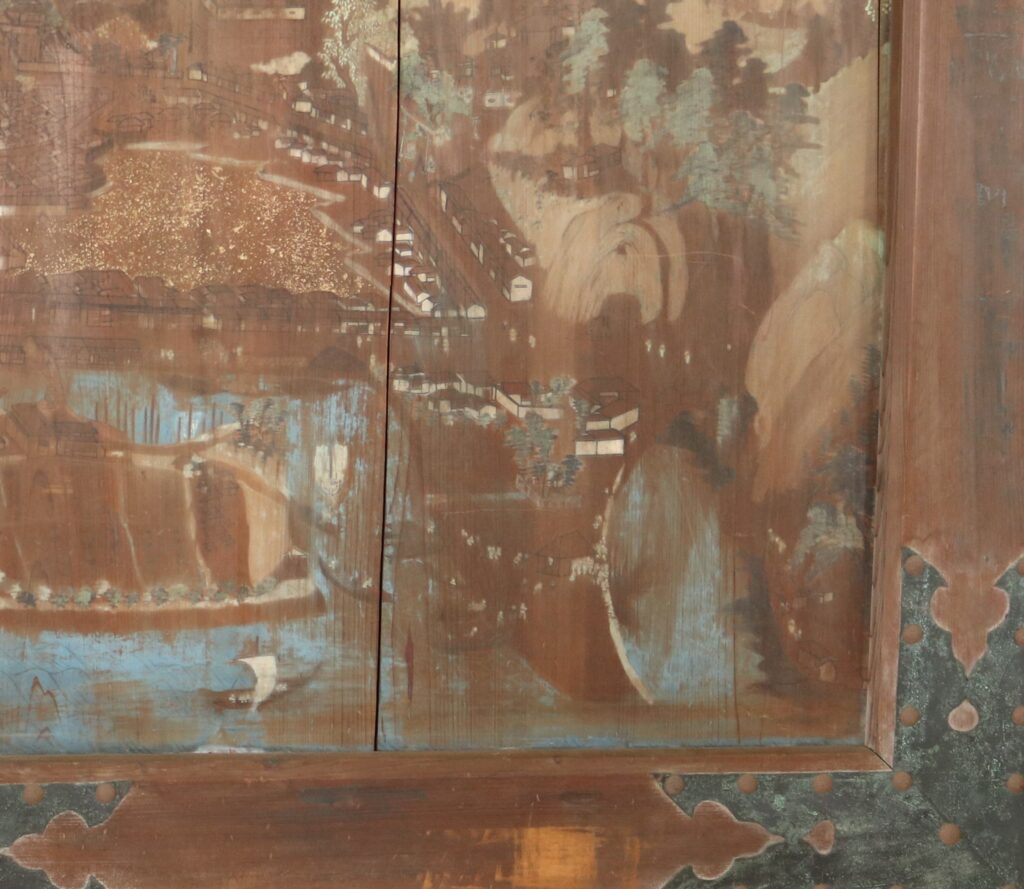
また、絵馬の右下の部分には、港で働く人々の姿や多くの船が見えます。
これは宇多津がこの時代に港町として栄えていたことを示しています。
沖に大型の船が見えますが、これは江戸時代の宇多津港がまだ浅く、大型船を受け入れられなかったため、小船で沖の大型船まで向かい、荷運びをしていたことを伝えています。
The bottom right shows workers and shipsin Utazu’s port.
→ This illustrates Utazu’s prosperity as a thriving port town.
Large ships anchored offshore, with smaller boats ferrying goods.
→ This tells us that Utazu’s port was too shallow for large vessels, so cargo had to be transferred via smaller boats.
このように、宇多津の繁栄の様子と家内安全などの願いがこもったこの絵馬には
町の歴史にまつわるたくさんのヒントが隠されているのです。
These details reveal not only the physical landscape of Utazu in the Edo period but also the desires and aspirations of its people—wishing for prosperity, safety, and success in trade.
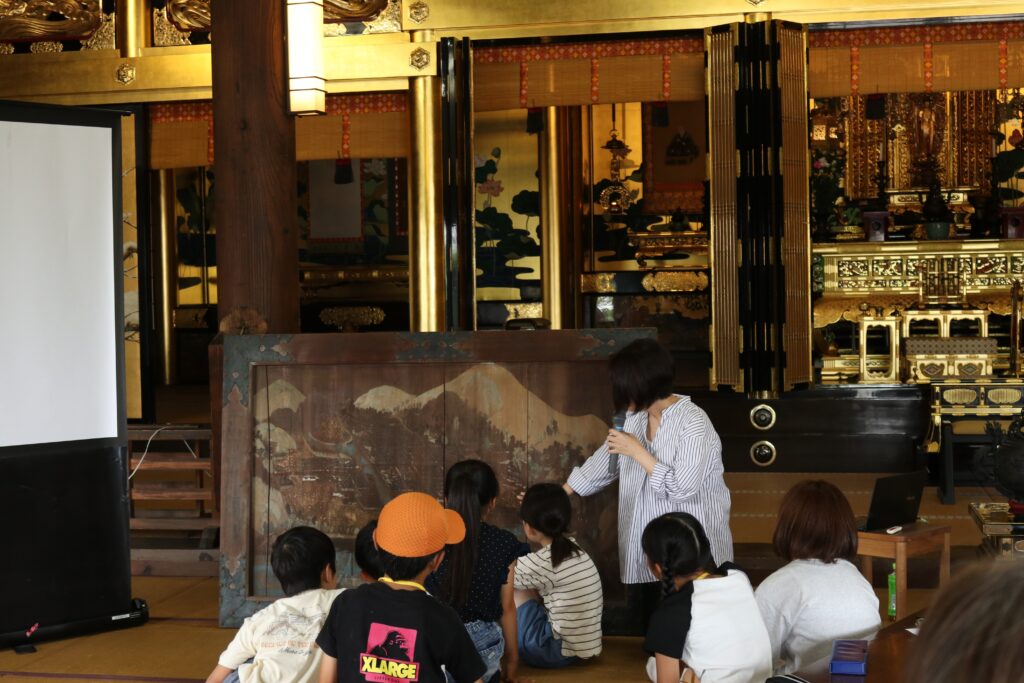
松岡さん
「この絵馬からは、昔の宇多津の様子だけではなく、当時の人々が伝えたかったことなども知ることができます。
細かい部分を見ていくと、さまざまな情報を読み取る事ができるので、皆さんも興味を持って観察して、宇多津の文化財を大切にしてくださいね」
What Can We Learn from Ema?
Matsuoka concluded the session with these words:
“Ema like this one don’t just show what Utazu looked like in the past—they also tell us what the people of that time wanted to share and remember. If you look closely at the details, you can uncover many stories hidden in the artwork. I hope you all take an interest in these cultural treasures and help preserve them for future generations.”
Through this experience, we gained a deeper appreciation for Utazu’s history, learning how art and cultural artifacts can serve as windows into the past.
Next time you visit a temple or shrine, take a closer look at the ema—you might discover an untold story waiting to be uncovered!